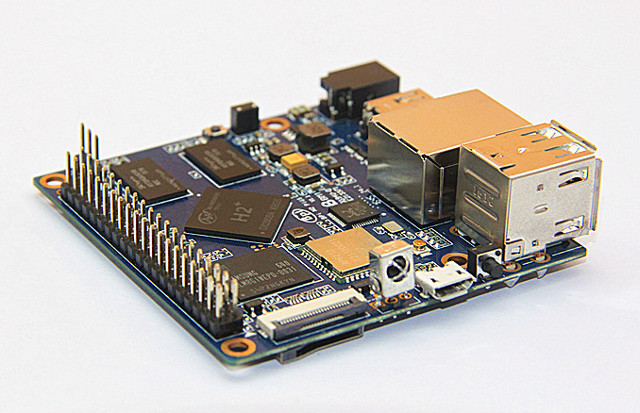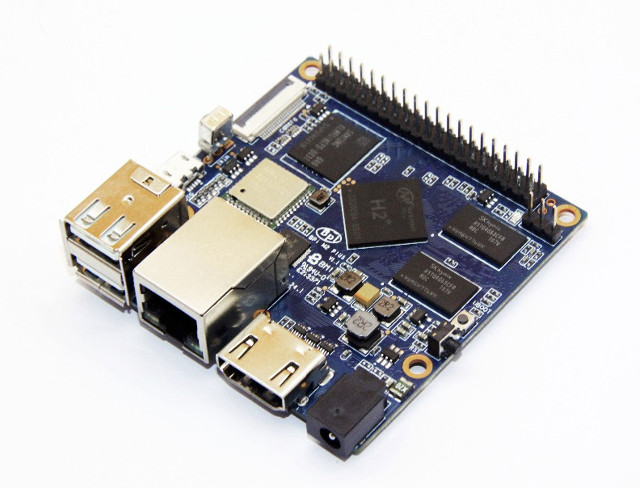Banana Pi BPI M2+ board was first released with Allwinner H3 processor, but the same PCB can also be used with Allwinner H2+ and H5 processors since the processors are pin-to-pin compatible, and SinoVoIP intends to release three version of the board, and just launched BPI M2+ (aka BPI H2+) with Allwinner H2+ processor for $34.50 + shipping, $1.5 cheaper than the H3 version also listed on Aliexpress. If you shop around, and don’t order on the official SinoVoIP store, you may find cheaper price for the boards. As expected, the specifications have not changed apart from the processor:
As expected, the specifications have not changed apart from the processor:
- SoC – Allwinner H2+ quad core Cortex A7 @ 1.2 GHz with an ARM Mali-400MP2 GPU up to 600 MHz
- System Memory – 1GB DDR3
- Storage – 8GB eMMC flash, micro SD card slot up to 64GB,
- Video & Audio Output – HDMI with CEC support
- Connectivity – Gigabit Ethernet, 802.11 b/g/n WiFi + Bluetooth 4.0 (AP6212)
- USB – 2x USB 2.0 host ports, 1x micro USB OTG port
- Camera – CSI Interface for 8-bit YUV42 CMOS sensor up to 1080p30
- Expansions – 40-pin Raspberry Pi compatible header
- Debugging – 3-pin UART header for serial console
- Misc – Power, recovery, and u-boot buttons; Power and status LEDs, IR receiver
- Power Supply – 5V/2A via power barrel (micro USB OTG port does not support power input)
- Dimensions – 65mm × 65mm
- Weight – 48 grams
The processors are not that different either, with Allwinner H3 supporting 4K video decoding and output up to 30 Hz, while H2+ is limited to 1080p60. The rest of the features look exactly the same. The company’s BPI M2+ page is all about the H3 version but most parts should be identical for the new boards. Supported operating systems include Android 4.4, Ubuntu 16.04 (Mate), Kano, Raspbian, Debian 8 and more according to the Download page, but none of them are likely to be working perfectly, and I’m not 100% sure they are working on the new H2+ board since they were all released last year, except Android 4.4 (Jan 2017). It might just be a case of updating the Device Tree (DTB) file however. [Update: I forgot the images are based on an ancient Linux 3.4 kernel, so not device tree here].
 You may also wonder why Orange Pi Zero board with the same H2 processor sells for $7, while that new board goes for about $35… One of the reasons is that Banana Pi boards are generally more expensive, but the price gap is mostly due to vastly different hardware specifications: 256 to 512MB DDR3, no eMMC flash, no HDMI output, Fast Ethernet, no camera support, smaller board, etc…
You may also wonder why Orange Pi Zero board with the same H2 processor sells for $7, while that new board goes for about $35… One of the reasons is that Banana Pi boards are generally more expensive, but the price gap is mostly due to vastly different hardware specifications: 256 to 512MB DDR3, no eMMC flash, no HDMI output, Fast Ethernet, no camera support, smaller board, etc…

Jean-Luc started CNX Software in 2010 as a part-time endeavor, before quitting his job as a software engineering manager, and starting to write daily news, and reviews full time later in 2011.
Support CNX Software! Donate via cryptocurrencies, become a Patron on Patreon, or purchase goods on Amazon or Aliexpress




